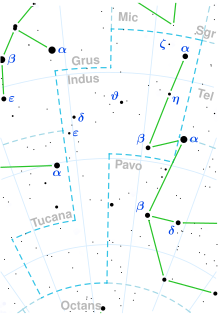astro.wikisort.org - Star
Alpha Indi (α Ind, α Indi) is a third magnitude giant star in the constellation Indus, located about 98 light years from the Earth.[1] The stellar classification of this star is K0 III-IV,[5] so it has exhausted the hydrogen at its core and evolved away from the main sequence. It has about double the mass of the Sun and is an estimated billion years old.[4] As a giant star it has expanded to about 12 times the radius of the Sun.[6] The effective temperature of the photosphere is 4,893 K,[7] giving it the characteristic orange hue of a K-type star.[9] It may have two nearby M-type companion stars, which are located at least 2,000 Astronomical Units from the primary.[10]
 | |
| Observation data Epoch J2000 Equinox J2000 | |
|---|---|
| Constellation | Indus |
| Right ascension | 20h 37m 34.03201s[1] |
| Declination | –47° 17′ 29.4026″[1] |
| Apparent magnitude (V) | 3.11[2] |
| Astrometry | |
| Radial velocity (Rv) | −1.3[3] km/s |
| Proper motion (μ) | RA: +49.24[1] mas/yr Dec.: +66.53[1] mas/yr |
| Parallax (π) | 33.17 ± 0.18 mas[1] |
| Distance | 98.3 ± 0.5 ly (30.1 ± 0.2 pc) |
| Absolute magnitude (MV) | 0.65[4] |
| Characteristics | |
| Spectral type | K0 III–IV[5] |
| U−B color index | +0.79[2] |
| B−V color index | +1.00[2] |
| Details | |
| Mass | 2.0[4] M☉ |
| Radius | 12[6] R☉ |
| Surface gravity (log g) | 3.00[7] cgs |
| Temperature | 4,893[7] K |
| Metallicity [Fe/H] | +0.03[7] dex |
| Age | 1[4] Gyr |
| Other designations | |
| Database references | |
| SIMBAD | data |
In China, this star is called Pe Sze where it also was known as the Persian, a title from the Jesuit missionaries.[11] The term Pe Sze is from the name of asterism 波斯 (Bō Sī, English: Persia). In Chinese astronomy, consequently, α Indi itself is known as 波斯二 (Bō Sī èr, English: the Second Star of Persia)[12]
References
- van Leeuwen, F. (November 2007). "Validation of the new Hipparcos reduction". Astronomy and Astrophysics. 474 (2): 653–664. arXiv:0708.1752. Bibcode:2007A&A...474..653V. doi:10.1051/0004-6361:20078357. S2CID 18759600.
- Johnson, H. L.; et al. (1966), "UBVRIJKL photometry of the bright stars", Communications of the Lunar and Planetary Laboratory, 4 (99): 99, Bibcode:1966CoLPL...4...99J
- Evans, D. S. (June 20–24, 1966), "The revision of the general catalogue of radial velocities", in Batten, Alan Henry; Heard, John Frederick (eds.), Determination of Radial Velocities and their Applications, Proceedings from IAU Symposium no. 30, vol. 30, University of Toronto: International Astronomical Union, p. 57, Bibcode:1967IAUS...30...57E
- Thorén, P.; Edvardsson, B.; Gustafsson, B. (October 2004), "Subgiants as probes of galactic chemical evolution", Astronomy and Astrophysics, 425: 187–206, arXiv:astro-ph/0407260, Bibcode:2004A&A...425..187T, doi:10.1051/0004-6361:20040421, S2CID 2116895
- Gray, R. O.; et al. (July 2006), "Contributions to the Nearby Stars (NStars) Project: Spectroscopy of Stars Earlier than M0 within 40 parsecs: The Northern Sample I", The Astronomical Journal, 132 (1): 161–170, arXiv:astro-ph/0603770, Bibcode:2006AJ....132..161G, doi:10.1086/504637, S2CID 119476992
- Pasinetti Fracassini, L. E.; et al. (February 2001), "Catalogue of Apparent Diameters and Absolute Radii of Stars (CADARS) - Third edition - Comments and statistics", Astronomy and Astrophysics, 367 (2): 521–524, arXiv:astro-ph/0012289, Bibcode:2001A&A...367..521P, doi:10.1051/0004-6361:20000451, S2CID 425754
- Gratton, R. G.; Ortolani, S. (November 1986), "The forbidden O/Fe ratio in metal-poor late-type stars", Astronomy and Astrophysics, 169 (1–2): 201–207, Bibcode:1986A&A...169..201G
- "alf Ind -- Star in double system", SIMBAD, Centre de Données astronomiques de Strasbourg, retrieved 2011-12-12
- "The Colour of Stars", Australia Telescope, Outreach and Education, Commonwealth Scientific and Industrial Research Organisation, December 21, 2004, archived from the original on March 18, 2012, retrieved 2012-01-16
- Kaler, James B., "THE PERSIAN (Alpha Indi)", Stars, University of Illinois, retrieved 2011-12-23
- Star Name - R.H.Allen p. 246
- (in Chinese) AEEA (Activities of Exhibition and Education in Astronomy) 天文教育資訊網 2006 年 7 月 30 日)
На других языках
[de] Alpha Indi
α Indi ist mit einer scheinbaren Helligkeit von +3,11 mag der hellste Stern im Sternbild Indianer. Er befindet sich in einer Entfernung von etwa 100 Lichtjahren und befindet sich am Übergang zwischen dem Stadium eines Unterriesen in einen Roten Riesen. Der Stern hat möglicherweise zwei leuchtschwache Begleiter, welche sich in einer Entfernung von mindestens 2000 AE befinden.[2]- [en] Alpha Indi
[es] Alfa Indi
Alfa Indi (α Ind / HD 196171 / HR 7869)[1] es la estrella más brillante en la constelación de Indus, el indio, con magnitud aparente +3,11. Es conocida por los nombres de Persian («La Persa»), título otorgado por los misioneros jesuitas, y Pe Sze ((波斯)), este último en el marco de la astronomía china.[2] De acuerdo a la nueva reducción de los datos de paralaje de Hipparcos, se encuentra a 98 años luz de distancia del Sistema Solar.[ru] Альфа Индейца
Альфа Индейца (α Indi, α Ind) — звезда-гигант третьей звёздной величины в созвездии Индейца; находится на расстоянии около 98 световых лет от Солнца.[1] Спектральный класс звезды — K0 III-IV,[6] звезда исчерпала запасы водорода в ядре и уходит с главной последовательности. По массе звезда вдвое превосходит Солнце, возраст оценивается в миллиард лет.[5] Радиус звезды составляет 12 радиусов Солнца.[7] Эффективная температура фотосферы составляет 4893 K,[8]звезда имеет оранжевый цвет.[10] Возможно, звезда имеет два компаньона спектрального класса M, расположенных по меньшей мере в 2000 а.е. от главной звезды.[11]Другой контент может иметь иную лицензию. Перед использованием материалов сайта WikiSort.org внимательно изучите правила лицензирования конкретных элементов наполнения сайта.
WikiSort.org - проект по пересортировке и дополнению контента Википедии